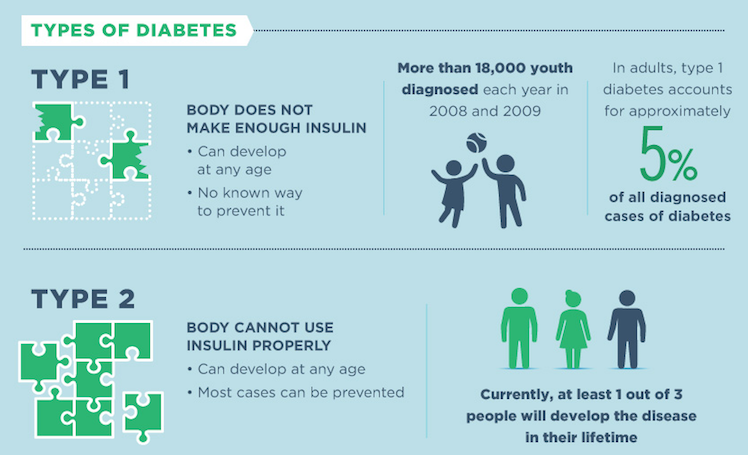DIABETES – A CLOSER LOOK
Diabetes mellitus (simply called Diabetes) is a metabolic disease where the blood sugar levels are higher than the normal range. Diabetes mellitus is a metabolic condition that prevents your body from properly using the energy from the food you eat because your body can’t make sufficient insulin or because you can’t use it correctly, resulting in high blood glucose levels (Hyperglycemia) that can lead to chronic hyperglycemia is associated with long-term damage, dysfunction, and failure of various organs, especially the eyes, kidneys, nerves, heart, and blood vessels.
| Type | FPG (mg/d L) | PPG(mg/d L) | A1c (%) |
|---|---|---|---|
| Normal | < 100 | < 140 | 5.7 |
| Prediabetes | > 100 – < 125 | > 140 – < 200 | > 5.7 – < 6.5 |
| Diabetes | > 126 | > 200 | > 6.5 |
TYPE OF DIABETES

Gestational diabetes: Gestational diabetes mellitus (GDM) is defined as any degree of glucose intolerance with onset or first recognition during pregnancy.
SYMPTOMS OF DIABETES
Most diabetes patients do not experience any obvious symptom, but some patients may experience weight loss, increased thirst, increased appetite, increased urination, blurry vision, elevated cholesterol levels, elevated blood pressure, sexual problems, numbness and tingling, fatigue, slow healing of wounds, and itchy skin.
DIABETES COMPLICATIONS
High blood glucose for a prolonged period may damage your micro-blood vessels of the eye (retinopathy), kidney (nephropathy), and nerves (neuropathy) and macro-blood vessels of the heart (coronary heart disease), brain (stroke) and lower extremities (peripheral vascular disease).
PREVENTION AND MANAGEMENT
Lifestyle changes such as losing weight, eating healthy and engaging in regular, moderate physical activity may reduce the progression of Type 2 diabetes.
The key to eating with diabetes is to eat a variety of healthy foods from all food groups, in the amounts your meal plan outlines.
TYPE OF DIABETES
-
Vegetables
-
nonstarchy: includes broccoli, carrots, greens, peppers, and tomatoes
-
starchy: includes potatoes, corn, and green peas
-
-
Fruits—includes oranges, melon, berries, apples, bananas, and grapes
-
Grains—at least half of your grains for the day should be whole grains
-
includes wheat, rice, oats, cornmeal, barley, and quinoa
- examples: bread, pasta, cereal, and tortilla
-
-
Protein
-
lean meat
-
chicken or turkey without the skin
-
fish
-
eggs
-
nuts and peanuts
-
dried beans and certain peas, such as chickpeas and split peas
-
meat substitutes, such as tofu
-
-
Dairy—nonfat or low fat
-
milk or lactose-free milk if you have lactose intolerance
-
yogurt
-
cheese
-
EXERCISE
Physical activity is an important component of the treatment plan for those with type 2 diabetes. It’s also important to have a healthy meal plan and maintain the blood glucose level through medications or insulin, if necessary.
Keeping a check on the blood glucose level is essential to preventing long-term complications, such as nerve pain and kidney disease.




